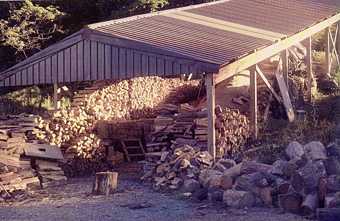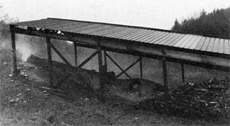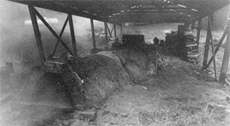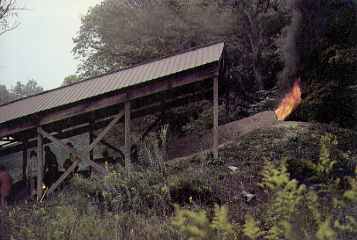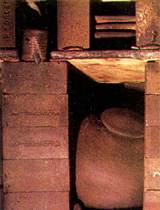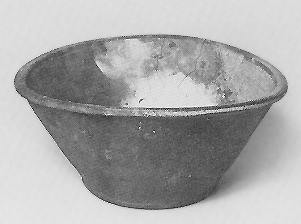
| Busbee Home Ceramics Home |
| Ceramics Monthly is the world's leading magazine on pottery and ceramic sculpture. |
|
|
|
|
![]() lames
subsided at the flue, then the damper, then the top peephole. We stoked
small wood, a handful. Opened the stoke holes halfway and slid wood in.
Smoke, but not too much. A single stimulus; a single response. Flames
receded and we stoked. A heavy clay hole cover fell off, and I felt its
weight on the steel bar while replacing it. I felt heat on my face, felt sweat drip, heard bark sizzle, smelled oak burning. Our world was our physical senses, and firing the kiln.
lames
subsided at the flue, then the damper, then the top peephole. We stoked
small wood, a handful. Opened the stoke holes halfway and slid wood in.
Smoke, but not too much. A single stimulus; a single response. Flames
receded and we stoked. A heavy clay hole cover fell off, and I felt its
weight on the steel bar while replacing it. I felt heat on my face, felt sweat drip, heard bark sizzle, smelled oak burning. Our world was our physical senses, and firing the kiln.
| Begun three weeks earlier, the woodfiring workshop was led by John Chalke, with Jack Troy as guest artist. We were the first Westerners to be in charge of firing this kiln. As the new ceramics resident at Peters Valley, I had become concerned with the state of contemporary anagama firing, which has such a highly specific and overwhelmingly seductive reference that the almost universal tendency has been to produce work in keeping with Japanese tradition. Rarely has anything boldly of our time been produced in an anagama kiln.
"Still, one student of European descent lobbied for a Buddhist lighting ceremony. I asked him if he said a Lutheran prayer whenever he lit a salt kiln, because that tradition began in Germany." Upon arriving at Peters Valley two months before the workshop, I deleted "anagama" from my vocabulary, using instead the general term "wood kiln" so that students would see a more general potential. Still, one student of European descent lobbied for a Buddhist lighting ceremony. I asked him if he said a Lutheran prayer whenever he lit a salt kiln, because that tradition began in Germany. When John Chalke arrived, we discussed an Americanization of the wood kiln. John, an advocate of a Western approach to anagama firing, suggested we name the kiln Emily and refer to our workshop as the "Americanization of Emily." Later, in deference to John's being British Canadian, it became the "Internationalization of Emily." A few days into the workshop, philosophies lightly clashed. Four of us (John, Bob Scherzer, Laura Burch and I painted ware with colored slips as we do in much of our work, while Karen Copensky carved fish and birds on her pots. Jack Troy, who lets the fire decorate the form, finally said, "Everette, I sure hope you leave one of your platters plain so I can lean it against one of my jars and just let the fire work on it." Aesthetics and wood consumption The aesthetics of decoration required no group resolution, unlike attitudes toward firing. The length of the firing affects ash buildup, and quick cooling can affect glaze surface. But intertwined with the issue of ash buildup is the problem of wood consumption and stoking labor. Cut and split firewood is one of the most expensive fuels available to potters today; wood from inexpensive sources invariably means intense hauling and processing. I've been told $100 a month hires a full-time wood cutter in Korea. The American solution too often has been to use students as cheap labor. At Peters Valley, I wanted to be able to wood fire outside the workshop season, when the making and loading of pots could be slower, quieter, removed from workshop responsibilities and deadlines. This would require a practical schedule for a short, fuel-efficient firing, rather than the two-week firings typical of this kiln in the past. So at the first workshop meeting, I suggested a four-day firing. But Jack said that anyone unprepared to fire for at least a week or anyone interested in efficiency ought not fire an anagama, because a long, inefficient firing gave the only worthwhile results. John chose the compromise length of five or six days. We ended up stoking slightly over four days, with an overnight propane candling of 12 hours. A rapid temperature increase the second day caused us to spend most of the third day merely soaking. At Jack's suggestion, we began vigorously shaking the bed of coals every half hour to increase ash deposition. Seeing ash running down pots, we finished firing on the fourth day. Mudding up the door After tossing in the last logs and mudding up the door, we sat silently in front of the kiln. Matt Povse opened a bottle of wine and passed it around. Matt, who had pots in the kiln and took several shifts firing, was our one thin link with the past. As director of Peters Valley, he had seen the kiln fired once before. The firing had been short, and I thought a quick cooling would be ideal, rather than the week-long coolings that are such massively unproductive periods in a workshop. So at the meeting on cooling, I was again the radical and Jack the conservative, while John mediated. As it turned out, we had drawn a lot of air through the door during side stoking, and with the damper up and the flue partially covered during cooling, the kiln lost its color within 18 hours. Meanwhile, John, Bob, Laura and I went to New York City. At the Metropolitan Museum of Art, we stood (perhaps still smelling of smoke) in front of four medieval Japanese wood-fired jars. Back home, John and Bob presented Laura and me with anagama T-shirts. The word anagama began to creep back into my vocabulary. I was glad I had left some of my pots undecorated. Unbricking the door The kiln door came down on the third day. We unloaded amidst the snapping and crashing of trees in the forest as hurricane Gloria hit. Power lines fell and a limb hit a truck belonging to class assistant Bill Forst, but unloading continued. John Chalke's plates had been thrown on a slowly turning wheel. Reminiscent of English redware basins with sharply angled, straight sides, they relied on flashing rather than heavy ash buildup. They were fired with clay stencils over similarly shaped slip silhouettes, a technique that directly controls the fire's "shadow," normally seen only when pots are placed in front of others or when wadding is used. Jack Troy's teabowls, bottles and storage jars exhibited a more traditional anagama-fired look. They were smooth surfaced, with dark browns and reds broken by lighter colored ash deposits. Jack knows what he wants and has success in getting it.
"Today we rarely experience such prolonged intensity in the struggle toward a common goal." I am less sure of what I want from an anagama firing. I clearly know I want dissonance, which in my brightly colored, heavily decorated earthenware is derived not only from its crudeness, but also from the sheer magnitude of decoration. This approach is antithetical to traditional anagama firing, with simple forms becoming canvases for the fire. That uncertainty about desired results does not extend to desired approach. I want the anagama firing to be innovative, to deal with artistic concerns of contemporary America. I want to see work that excites, delves into the unknown and fits squarely into the late 20th century. The goal for the next firing is a day on propane, three days of stoking (which should provide a moderate ash buildup with a moderate amount of wood) and three days of cooling. Ideally, for a month-long workshop, wood handling should be no longer than three or four days, primarily during loading and propane candling. This will allow more time to be spent in the most important area, making things in clay. This firing was good. There had been no lighting ceremony to appease the wind. We are modern Western potters, who buy our clay in bags, and fire our kilns aware of the physics of quartz inversion and the chemistry of oxidation and reduction. Yet the firing was filled with a spirit. It came from potters working together, eating together, firing together, laughing together. We depended on others to control the firing as we ate and slept, and they in turn depended on us. Today we rarely experience such prolonged intensity in the struggle toward a common goal. This firing will be with me for a long time. |
||
|
|||
|
|||
|
|||
|
|||
|
|||
|
|||
|
|||
|
|||
|
